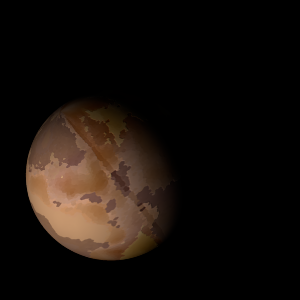|
|
Space Astro
|
Info for exoplanet "Tejotqeq"
| Scientific (actual) data |
|---|
| Name | Kepler-1113 b |
| Planet status | Confirmed |
| Radius | 0.251 |
| Orbital period | 42.3005 |
| Discovered | 2016 |
| Updated | 2021-02-05 |
| Tconj | 2455000 |
| Publication | Announced on a website |
| Detection type | Primary Transit |
| Alternate names | 2MASS J19173761+3920198 b, K02134.01, KIC 4254466 b, KOI-2134 b, KOI-2134.01, WISE J191737.69+392019.8 b |
| Star name | Kepler-1113 |
| Right ascension | 289.41° |
| Declination | 39.34° |
| Mag j | 13.552 |
| Mag h | 13.292 |
| Mag k | 13.191 |
| Star distance | 1127 |
| Star metallicity | 0.18 |
| Star mass | 1.12 |
| Star radius | 1.17 |
| Star age | 3.55 |
| Star temperature | 5931 |
| Star alternate names | 2MASS J19173761+3920198, KIC 4254466, KOI-2134, WISE J191737.69+392019.8 |
| Wikipedia article | Kepler-1113 b |
Back
| |
| Fictional info (?) |
|---|
| Suggested name | Tejotqeq |
| Planet type | Cold planet |
|
| Atmosphere | Carbon dioxide | 39% |
| Neon | 34% |
| Ethane | 12% |
| Formaldehyde | 10% |
| Hydrogen deuteride (HD) | 2.7% |
| 2H2O | 1.6% |
| Nitric oxide | 0.086% |
| Ammonium hydrosulfide (NH4SH) | 0.0053% |
| Atmospheric pressure | 31 bar |
 |
| Moon | Geldi'malen Aepan | Very small slightly egg-shaped gaseous moon |
| Jotauto Monahe | Medium-sized round ice moon |
| Chame Isorosa | Medium-sized potato shaped rocky asteroid |
| Mnetha | Small round crater-filled asteroid |
| Google search for Tejotqeq |
|
Website by Joachim Michaelis
|
|
|
|